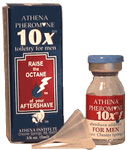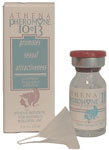What are Pheromones? The Published Science Athena Pheromones Discovery News
The Human Pheromone Discovery
Dr. Cutler explains her discovery of human pheromones...

"Throughout the animal kingdom, it was well known (by 1979) that females emit sex attractants that cause males (of the same species) to approach. Animal pheromones were so well understood, by the late 70's, that manufacturers were marketing them as pest controls; pheromones were used to lure and divert animals and bugs to traps to prevent crop and flower damage. I was fortunate to be one of the scientists working on the research that proved the existence of human pheromones for the first time.
The discovery of human sex pheromones appeared in front page stories internationally when my colleagues and I succeeded in peer-reviewed acceptance for publication in scientific journals in 1986. We provided the proof that women and men emitted pheromones into the atmosphere and we showed that extracted pheromones could be collected, frozen for over a year, thawed and then applied topically above the upper lip of recipients to mimic some of the pheromonal effects found in nature."
To Review Dr. Cutler's sexuality findings that led to the Pheromone discovery click here
Dr. Winnifred Cutler's 1986 pheromone research generated media coverage in major newspapers and magazines: click on title to see full details...
The Washington Post, Page 1., 11/18/86.
Pheromones Discovered in Humans
Copyright -The Washington Post Newspaper.
by Boyce Rensberger
"Scientists in Philadelphia have established for the first time that the human body produces pheromones, special aromatic chemical compounds discharged by one individual that affect the sexual physiology of another. Although animals have long been known to secrete pheromones, which typically function as sex attractants, and although the existence of such chemicals in humans has long been speculated, the new research is the first to establish their existence in humans" - more details click here
Time Magazine, 12/1/86
Studies find that male pheromones are good for women's health
Copyright Time, Inc. By John Leo
Reported by Robert Ajemian
Women who work or live together tend to get their menstrual cycles in sync. That curious phenomenon known for years by scientists and many ordinary folk, has long been suspected as an indication that humans, like insects and some mammals, communicate subtly by sexual aromas known as pheromones. Last week Philadelphia researchers weighed in with two reports showing that scents, including underarm odors, do indeed affect menstrual cycles. The reports came with a kicker: male scents play a role in maintaining the health of women, particularly the health of the female reproductive system. Researchers at the Monell Chemical Senses Center and the University of Pennsylvania School of Medicine have found that women who have sex with men at least once a week are more likely to have normal menstrual cycles, fewer infertility problems and a milder menopause than celibate women and women who have sex rarely or sporadically.
So the researchers were hardly tentative about the meaning of it all. "What we're saying here is that men are really important for women," said Winnifred Cutler, a biologist and specialist in behavioral endocrinology who conducted the study along with Organic Chemist George Preti. "If you look at all the data, the conclusion is compelling. A man or his essence seems essential for an optimally fertile system." more details click here
USA Today, 11/19/86
The Real Chemical Reaction Between the Sexes
Copyright -USA Today
by Kim Painter
Chemicals in men's bodies can cause their female sex partners to be more fertile, have more regular menstrual cycles and milder menopause, landmark research shows. And women who have sex with men at least once a week benefit most from the chemicals, which apparently work through the sense of smell.
"The exciting part is the effect we have on each other. Men are important to women," says Dr. Winnifred B. Cutler of Philadelphia, whose studies show for the first time that chemicals called pheromones exist in humans. Pheromones have long been known to exist in animals, as scents that attract sex partners. Cutler's new studies...show women are affected by pheromones from men and women:

*Women with unusually long or short menstrual cycles get closer-to-average cycles after regularly inhaling male essence, described as a compound of male sweat, hormones and natural body odors. "You just walk into a male locker room," Cutler says, "that's the odor."
*Women exposed to another woman's "female essence" menstruated at the same time after a few months, confirming a long-observed phenomenon that women who live together menstruate at the same time.
Cutler's other studies show women who have sex with men at least once a week have regular menstrual cycles and fewer fertility and menopause problems, apparently because of exposure to pheromones.
Newsweek, 1/12/87.
The Chemistry Between People: Are Our Bodies Affected by Another Person’s Scent?
Copyright Newsweek Magazine
By Terence Monmaney with Susan Katz
The air is loaded with secrets, with intimate messages both unseen and unheard. Ready! A female moth announces, and male moths miles away soon receive the invitation and head upwind, eager to mate. A dog goes into heat, and male dogs all over the neighborhood are drawn by a telltale scent to her masters’ door.
In creatures as different as bugs and dogs, life-and-death messages are relayed via a specialized chemical known as a pheromone - a substance that works much like a hormone, but is released by one individual and prompts changes in the physiology or behavior of another.
Ever since scientists discovered pheromones 30 years ago, they’ve found such chemical communication in hundreds of species - from moths to mice to monkeys. And man? Do we, the great communicators, also make use of such potent and unambiguous signals? Is there literal truth to the notion that when people get along, it is because of the right "chemistry"?
There have been plenty of claims. A mother's pheromones, researchers once said, are what attract her infant to her breasts. *** But while the idea of human pheromones is intriguing, the dozens or so studies that addressed the possibility in the past 10 years were disappointing: no one established beyond a doubt that human pheromones exists.
Now two new studies are stirring up the pheromone debate with the boldest claims yet. Researchers at the University of Pennsylvania and the Monell Chemical Senses Center, a nonprofit research institute in Philadelphia, say that people produce underarm pheromones that can influence menstrual cycles.
The studies, done by chemist George Preti and biologist Winnifred B. Cutler, are not the first of their kind, but they are the first ones rigorous enough to be published in a respected scientific journal, Hormones and Behavior.
In one study the researchers collected underarm secretions from men who wore a pad in each armpit. This "male essence" {pheromone} was then swabbed, three times a week, above the upper lips of seven women whose cycles typically lasted less than 26 days or more than 33. By the third month of such treatment, the average length of the women's cycles began to approach the optimum 29.5 days - the cycle length associated with highest fertility.
Cutler's conclusion: " Male essence" contains at least one pheromone that "helps promote reproductive health".
for more details click here
Dr. Cutler's pheromone science has been "bottled" into vials of unscented fragrance additives that increase wearers' sexual attractiveness. AVAILABLE FOR PURCHASE HERE
CNN Online, and WebMD.com article, 6/25/99
Pheromones: Potential participants in your sex life
By Deb Levine
Copyright WebMD.com
In 1986 Dr. Winnifred Cutler, a biologist and behavioral endocrinologist, co discovered pheromones in our underarms. She and her team of researchers found that once any overbearing underarm sweat was removed, what remained were the odorless materials containing the pheromones.
Dr. Cutler's original studies in the '70s showed that women who have regular sex with men have more regular menstrual cycles than women who have sporadic sex. Regular sex delayed the decline of estrogen and made women more fertile. This led the research team to look for what the man was providing in the equation. By 1986 they realized it was pheromones.
Related Links:

